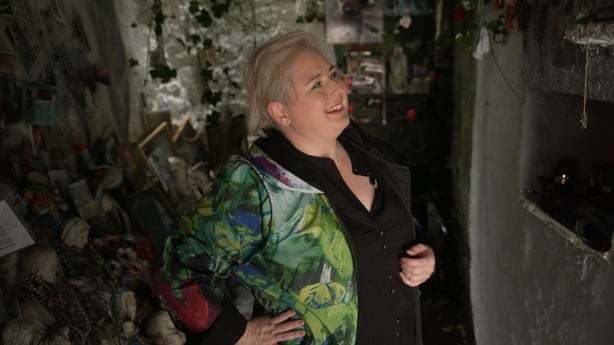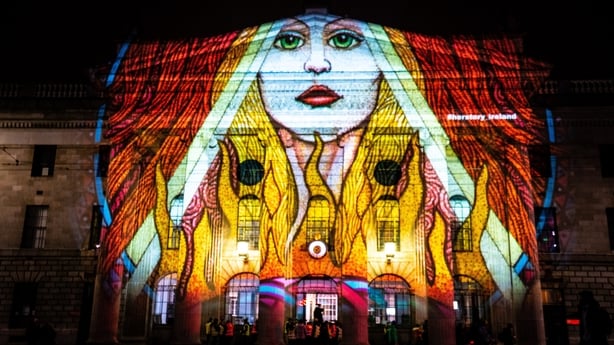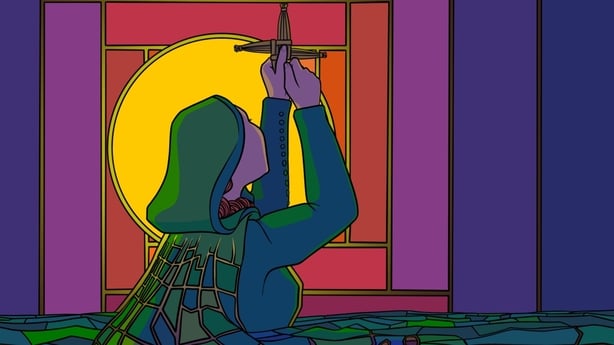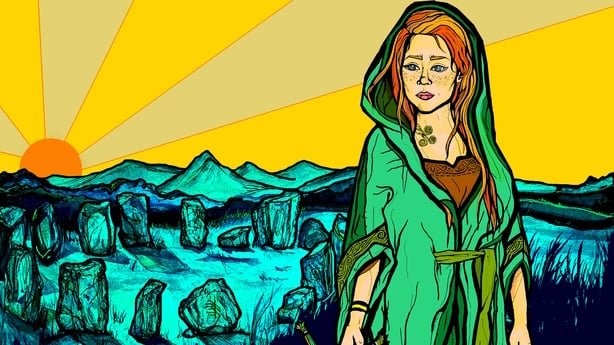On St Brigid’s Eve, as Ireland prepares to celebrate its first public holiday dedicated to a woman, Siobhán McSweeney, of Derry Girls fame, goes in search of the real Brigid for the new RTÉ One documentary Finding Brigid - watch it now, via RTÉ Player.
Through a series of encounters, 1500 years after Brigid’s death, Siobhán attempts to unravel the tangled threads of fact and folklore, history and mystery, to reveal the truth about this elusive woman, saint and goddess; and she asks why, in an increasingly secular and diverse Ireland, Brigid's popularity appears to be on the rise.
As a child in West Cork, Siobhán McSweeney remembers weaving St Brigid’s crosses in school and putting out the Brat Bríde on Brigid’s eve. She was told stories about the Saint’s compassion, her magical cloak and the pioneering unisex monastery she founded and ran in Kildare. Having seen Brigid portrayed in Celtic fantasy books as "a kick-ass warrior poet and goddess", Siobhán had no hesitation in choosing Bríd as her confirmation name and saint.
Siobhán McSweeney is #FindingBrigid, tonight at 10.15pm 💚 @siobhni | @rteplayer pic.twitter.com/DapsWbrGTO
— RTÉ One (@RTEOne) January 31, 2023
She wasn’t alone. Brigid, Bríd, Breda, Bridie, Briege, Brídóg, Biddy… For generations, Irish girls have been named after Ireland's matron saint and her legacy is all around us - in our place names and the countless churches, schools and GAA clubs dedicated to her and hundreds of holy wells. It is beside one of these, in Liscannor, Co. Clare, that Siobhán’s search for the real Brigid begins, as she visits a grotto festooned with touching mementoes of generations of pilgrims, who have come here to pray, grieve or seek healing.
It’s obvious how much Brigid has meant to people in the past, but does she still have that significance? A few miles away, in a stone circle in Galway, Siobhán assembles an "awesome mnásome" - four modern women, each with a strong personal attachment to Brigid.
Broadcaster, Mary Kennedy, and her sister, Deirdre Ní Chinnéide, grew up by St Brigid’s well, in Clondalkin, and are co-authors of Journey to the Well, a book about spiritual renewal. Mary was surprised how much writing that book taught her about herself:
"I did feel that by researching and by writing about Brigid, I got more of a sense of me as a woman, as an Irish woman, as a woman with Celtic roots and a confidence."
Deirdre believes recognition of Brigid alongside Patrick is long overdue:
"I think it's time to own her and to claim her and to give her her day... It doesn’t make any sense to be celebrating St Patrick’s Day without St Brigid in that alignment as well."

The two sisters are joined by Laura Murphy, a poet and daughter of a mother and baby home survivor, and Herstory Founder & CEO Melanie Lynch, who candidly reveal their motivation behind the Herstory campaign and their mission to make St Brigid's Day a national holiday. Melanie explains:
"It was wrath, the fire that brought this campaign. It was the discovery of thousands of women’s stories I'd never heard about in school, and Brigid, and how she had been neglected... And that’s why we started the light shows with Herstory, because they literally have been in the darkness and in the shadows... We have this heritage, and it is time for her to reemerge."
Siobhán is struck by the fact that the qualities that each woman most admires in Brigid are the qualities she sees in them.
"In a way, I think I would argue that she [Brigid] is a mirror actually. She says more about the person who is looking at her than Brigid herself. But the idea of Brigid - the woman, the saint, the goddess, the story - is robust enough to carry whatever we want her to be.
But what of the actual person - the 6th century Abbess of Kildare, who, tradition has it, was the daughter of a pagan chieftain and his slave, who went on to become the most important Christian woman in Ireland and was ordained a bishop by St Mel, in recognition of her authority? Can we even be sure this woman existed? And how does that Brigid relate to the goddess figure revered in pagan circles.

for the Herstory Light Festival (Pic: Dodeca)
Dr Mary Condren, theologian and the Director of Women Spirit Ireland, explains how the lines between Christianity and Paganism became blurred in Brigid’s lifetime, a time of transition when the Christian faith was still new to this island. Brigid was perfectly placed to fuse the two traditions:
"Several popes in the 4th and 6th century argued, what the Church has to do is to go in and take all the so-called indigenous festivals and incorporate them... The only one they didn’t touch was Lughnasa because that one was too sexually orientated... There is a huge overlap, the so-called Christian traditions basically built on the pagan traditions."
Mary also sheds light on the saint’s name, which may explain why there are so many versions of Brigid: "It (Brigid) means 'the high or the exalted one.’ I think it refers in Ireland to a lineage of female authority... The title of Brigid... emphasises the important status of Brigid, the woman, in her own time. The Abbesses of Kildare...were the most important women of Ireland."
St Brigid’s Cathedral now stands on the original site of Brigid’s monastery, in Kildare. It was here that Brigid adopted a pre-Christian tradition of perpetual fire as a symbol for Christianity. Her fire, An Solas Bhríde, burned for the next thousand years, until a Tudor King, Henry VIII, quenched it, as he dissolved the monasteries. On the site of the original fire-pit, Siobhan meets historian Dr Niamh Wycherley, who believes it’s important not to lose site of this real, Christian woman amidst the accreted layers of myth:
"I think we are at a juncture now where we need to kind of reclaim this real Brigid, because she has been overshadowed for centuries by the so-called goddess Brigid and by the [other versions of] Saint Brigid with all their wonderful supernatural attributes and powers... But the real Brigid was inspirational enough for us not to have to create all these fantastical stories about her... She manages to found this community in Kildare, which becomes one of the most powerful and influential institutions in the country... She is a woman, explicitly defined as not equal to men in the Irish laws, yet she is being portrayed as equal to Patrick in many of these early Irish sources."

1500 years after Brigid was supposedly ordained Ireland’s first female bishop, Siobhán meets the second, the Church of Ireland Bishop of Meath and Kildare, Pat Storey, who sees her womanhood and her faith as connections with her predecessor every bit as strong as her title:
"I do see it as continuing certainly her spreading of the gospel of Christian faith... You just bring being a woman, you bring representing fifty percent of the population. My experience of being a woman and, as it happens, as a wife and a mother, obviously feeds into my Christian faith."
Not far from Kildare cathedral, Siobhán visits another Brigid’s Well with former President of Ireland, Mary McAleese, who sees in Brigid’s story and legacy a valuable expression of feminine, Irish spirituality, which has survived despite the best efforts of the male-dominated institutional Church to suppress it. That’s why she, herself, is so delighted to see Ireland finally re-acknowledging the importance of St Brigid’s Day
"Unfortunately, those narratives over the 2000 years of Christianity have been shaped by a real debt of misogyny that I think Brigid suffered from... And it [the holiday] is not just in her honour, it’s in honour of that whole tribe of people going back generations, who insisted that her story be told, because it was worth the telling and worth remembering...what we owe her."
It’s not only in Ireland that legends about Brigid abound. On the hallowed ground of Glastonbury, in the West of England, Siobhán hears a legend that Saint Brigid visited the place in her lifetime, bequeathing a whole trove of relics. On closer inspection, it appears more likely that it was one of her followers who came to this green hill far away, but archaeologist Brian Wright still reveals tantalising details of yet another lost-and-found legacy here. He sees Brigid as a perfect fusion – of cultures, traditions and even sexes:
"She represents not only femininity but also unification of the two sexes. You could say she links male and female, because she was abbess, but these were dual monasteries and she was more senior, as abbess, to the abbot."

That fusion is also evident in the central role afforded to Brigid in Glastonbury’s 27th annual Goddess Conference, which takes place during SIobhán’s visit. Donning appropriate regalia, Siobhán joins a Goddess procession to the iconic Tor to witness pagan dancing and incantation. And meets Dutch Priestess (and sometime lawyer) Marion Brigantia on Bride’s Mound, supposedly the site of a former chapel dedicated to Brigid. Marion explains:
"The goddess tradition is all about reclaiming of our wild selves, of our really primordial connection with the land... and as a goddess I think Brigid is very powerful."
There’s one more stop on Siobhán’s pilgrimage of discovery. Back in Kildare, the Brigidine Sisters are, like Brigid herself, members of a Christian religious order, who, in 1993, re-lit her sacred flame in their Solás Bhríde Centre for Spirituality. It’s burned ever since, attracting growing numbers of pilgrims from all over Ireland and further afield. Sr Rita Minehan explains to Siobhán why, in an increasingly secular and diverse Ireland, Brigid's popularity appears to be on the rise.
"She speaks to the issues of our time: a woman of the land - our planet is in danger; the woman of peace - the peacemaker; the woman of extraordinary outreach to the poor. She midwifed Christianity in Ireland and, hopefully, she is going to continue to midwife a new Ireland, a more caring, compassionate and sustainable country, as we go into the future."
Finding Brigid, RTÉ One, Tuesday 31st January at 10.15pm - watch it now, via RTÉ Player.

